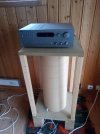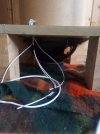Any proof, I'm asking for any? Me thinks not.
Some reply to the link to so called knocking tests at "hifi selbstbau" was:
Any correlation of knocking against a freely vibrating plate with the driving forces and subsequent motion when the ready-made enclosure is in actual operation? Me thinks not, just none.
So why is it, that You all refuse to investigate the made-up case any deeper than just citing irrelevant data from third parties, or reiterating wild speculations? And then You praise the "constraint layer" as a solution for a problem that isn't understood to the least; neither in regard to auditory relevance nor in regard to its possible origin.
This is exactly how the otherwise disregarded audiophile shmockery works. Invent an utterly irrelevant problem, propose a singular magical pseudo-science solution of Yours and make some money from missing education on the customer's side.
Congrats!
No , the reason why this is interesting to us former DIY:er , is that we KNOW that the sound from cabinet walls might color the sound , and in some cases, one can hear it.
Just look at these two pictures ( Elac B6 and below Genelec G3 ) cabinet resonanses measured from Stereophile, and read John Atkinsons comments :
”A prominent discontinuity in the traces just below 200Hz suggests that the enclosure has a serious resonance at that frequency. While setting up the speaker on my turntable stand to measure it, I noted that the cabinet seemed very lively—investigating the panels' vibrational behavior with a plastic-tape accelerometer, I found a very high-level, high-Q resonant mode at 188Hz that was present on all surfaces but highest in level on the side panels (fig.2). As HR wrote of the sound through the B6es of a recording of male voice and double bass, "I heard that vibrating box—not a little, but a
lot. . . . [The speakers] were vibrating like sex toys!" There are also some high-level resonant modes present in the midrange.”
…and Genelec G3 :
”I investigated the enclosure's vibrational behavior with a plastic-tape accelerometer. It was extremely inert. The only resonant mode I found was on the sidewall, at 637Hz (fig.1), but this is vanishingly low in level, even at SPLs >90dB.”
————-
…So as everyone can see - this is in certain cases a problem for sound quality .


